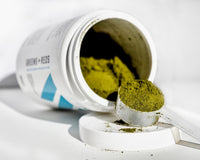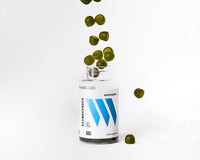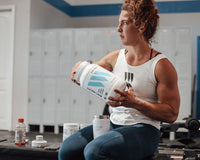We’ve all been there; sore to the point that we can barely move. When it hurts so bad, you can’t even raise your arms over your head. Or what about the days when you can’t even walk straight because you decided to throw some extra plates onto your deadlift the day before. What you’re experiencing is called Delayed Onset Muscle Soreness (DOMS), which unsympathetically decides to ruin your day typically 12-48 hours’ post-workout.
What Causes Delayed Onset Muscle Soreness?
A common misconception is that DOMS is caused by lactic acid accumulation, when in fact lactic acid is not a component of this process. DOMS is caused by the exercise-induced repair process, due to micro-tears in the muscle fiber.
Physical discomfort or acute muscle soreness after your workout is normal. However severe tenderness and debilitating pain is a common result from stressing the muscle tissue beyond the normal level of physical activity that you’re accustomed to. DOMS is contracted from the eccentric or lengthening motion of a specific workout (I.e. the sitting position in a squat, or de-loading motion in a Pecfly) causing microscopic tears to occur in the muscle tissue. This causes an inflammatory response, producing pain in the muscle, as well as the connective tissue and surrounding ligaments.
This micro-trauma can occur from changing the intensity, duration, weight load, or increasing the frequency of workouts or repetitions.
How Is DOMS Different Than Acute Muscle Soreness?
Acute muscle soreness is a direct result of intense physical activity, in which lactate can build in the muscle tissue and cause attenuation, or fatigue during or immediately after your workout. DOMS is different and typically starts to develop within 12-24 hours’ post-workout, and can greatly intensify reaching a climax pain threshold at 48 hours. The soreness associated with DOMS is painful and can be quite debilitating. When you get it, you’ll know it, because it’s shitty.
How Do You Treat Delayed Onset Muscle Soreness?
Many athletes and non-athletes experience DOMS at some point or another. However, there are ways in which you can reduce the soreness and physical discomfort associated with it. Certain nutritional intervention and post-exercise practices can effectively reduce and treat DOMS, specifically with the inflammatory response and accompanying induced muscle soreness.
1. Workout Nutrition
Nutritional intervention is one of the preventative and preferred methods by the body to effectively fight DOMS for both athletes and non-athletes. The nutrients you receive from the nutrients in your diet before and after exercising can reduce inflammation and oxidative stress, which are two major contributors to DOMS. Look for foods that include robust amounts of omega-3 fatty acids, glutamine, and polyphenols (flavonoids are a group of polyphenols that are both anti-inflammatory agents and antioxidants) [R].
RELATED ARTICLE Post Workout Nutrition: What To Eat After Your Workout2. Supplements For Muscle Soreness And Recovery
Krill Oil
Krill Oil helps with post-workout inflammation and contains Omega-3. Omega-3's contain fatty acids called eicosanoids, eicosapentaenoic acid (EPA) and docosahexaenoic acid (DHA). Eicosanoids have been reported to regulate the inflammatory response within the body. Krill Oil also contains a potent and powerful antioxidant which is also an anti-inflammatory called Astaxanthin. Supplementing Krill Oil will provide you with the EPA and DHA you need to help with the inflammatory response and treat DOMS.2
RELATED ARTICLE Krill Oil Vs Fish Oil: Which One Is Better?
RECOMMENDED PRODUCT Krill Oil (60 Servings)
L-Glutamine
One of the best supplements to help treat DOMS, is L-Glutamine. Glutamine is a conditionally essential amino acid, which helps repair and recover muscle mass after strenuous exercise by reducing muscle breakdown and exercise-induced muscle soreness [R]. In a double-blind crossover study, sixteen healthy participants were examined to find the influence of L-Glutamine on muscle strength recovery and soreness. With one gram of L-Glutamine supplementation per day, they found that participants had a faster recovery of muscle strength, and diminished muscle soreness following eccentric exercise in a 72-hour period [R].
RELATED ARTICLE L-Glutamine: The Best Supplement For Faster Recovery
RECOMMENDED PRODUCT: L-Glutamine (100 Servings, Unflavored)
Citrulline Malate
Citrulline Malate is made from the amino acid L-Citrulline and Malic Acid. Citrulline Malate facilitates the production of L-Arginine, a semi-conditional amino acid that promotes the release of Nitric Oxide (NO). NO plays an important role in many functions in the body regulating vasodilatation and blood flow, inflammation, and immune system activation. Since NO is a vasodilator, more blood flow and oxygen can reach the muscle tissue to help fight fatigue and enhance your athletic performance by maximizing endurance and VO2. More oxygen and blood flow also means optimized macronutrient uptake of protein, carbohydrates, and fats to your muscle tissue for better muscle repair, faster recovery, and increased strength.
RELATED ARTICLE The Health Benefits Of Citrulline Malate
RECOMMENDED PRODUCT Citrulline Malate (100 Servings, Unflavored)
Branched Chain Amino Acids (BCAA)
Leucine is the most prevalent and beneficial of the three branched chain amino acids (BCAA). Leucine and the other branched-chain amino acids, Isoleucine and Valine have been shown to promote protein synthesis and decrease muscle protein breakdown or degradation. In a double-blind crossover study published in the Journal of International Society of Sports Nutrition, 12 males, 6 administered a placebo, and 6 administered a BCAA supplement proved that with BCAA supplementation, pre and post-workout reduced muscle damage and accelerated muscle recovery [R].
RELATED ARTICLE Do BCAAs Work And What Do They Do?
RECOMMENDED PRODUCT BCAA (50 Servings, Lemon Lime)
DOMS can severely impact your progress and athletic performance. However implementing the right nutritional and supplement protocol into your training, can help reduce muscle soreness and the pitfalls of DOMS.
RELATED ARTICLE The Best Supplements For Faster Recovery
3. FOAM ROLLING
If you’re sore to the point where you can barely move, foam rolling definitely does not sound like a fun option. But according to a study published in the Journal Of Athletic Training, directed to investigate the effect of foam rolling on DOMS, found that just three 20-minute bouts (60 minutes total) of foam rolling, within the recovery period 12-72 hours can substantially enhance recovery after DOMS and alleviate muscle tenderness [R].
4. KINESIOLOGY TAPE
Kinesiology tape helps with joint support, along with increasing active blood flow, oxygen, and circulation of lymphatic fluid to optimize recovery. We recommend using Active Intelligence (AI) Tape, as it also contains active ingredients like Menthol and Capsaicin, to further enhance athletic performance through activated colling ingredients built directly into the tape.
5. FEEDER WORKOUTS
Performing high repetitions at a low-weight the day following your workout can dramatically help with supplying blood and oxygen to help relieve muscle soreness and trauma to the muscle tissue.
RELATED ARTICLE 11 Ways To Reduce Post-Workout Inflammation
How To Treat DOMS: The Takeaway
Everyone is susceptible to getting DOMS at some point in their training. However, as the saying goes, no pain, no gain! Various amounts of discomfort or pain and inflammation will be associated with high-intensity training and resistance training, depending on the frequency, intensity, duration, and type of exercise performed. By incorporating some of the best practices above, you can effectively treat DOMS to relieve your muscle soreness and post-workout inflammation so that your soreness doesn't keep you from your goals.
Looking for a way to reduce your post-workout muscle soreness and inflammation?
L-Glutamine is made with 100% pharmaceutical grade micronized L-Glutamine. Glutamine is a conditionally essential amino acid, which helps rebuild repair and recover muscle mass after strenuous exercise to reduce muscle breakdown and exercise-induced muscle soreness.* Glutamine also supports healthy immune function promotes a positive nitrogen balance and promotes protein synthesis. Faster recovery times between training sessions will help increase training volume and endurance.
SWOLVERINE is an endurance athlete and active lifestyle brand. Made for the elite athlete, and the strong-willed our products were designed to fuel your athletic performance. We perform when you perform.
We believe that everyone can optimize not only their athletic performance but their human potential. The way we believe we can optimize performance is through transparency, clinically effective doses, and clinically proven ingredients with evidence-based outcomes. We provide the nutrients you need to power your active lifestyle.
References
- Kim, Jooyoung, and Joohyung Lee. “A Review of Nutritional Intervention on Delayed Onset Muscle Soreness. Part I.” Journal of Exercise Rehabilitation6 (2014): 349–356. PMC. Web. 10 Oct. 2017. https://www.ncbi.nlm.nih.gov/pmc/articles/PMC4294436/
- Jouris KB, Mcdaniel JL, Weiss EP. The Effect of Omega-3 Fatty Acid Supplementation on the Inflammatory Response to eccentric strength exercise. J Sports Sci Med. 2011;10(3):432-8.
- Howatson G, Hoad M, Goodall S, Tallent J, Bell PG, French DN. Exercise-induced muscle damage is reduced in resistance-trained males by branched chain amino acids: a randomized, double-blind, placebo controlled study. J Int Soc Sports Nutr. 2012;9:20.
- Pearcey, Gregory E. P. et al. “Foam Rolling for Delayed-Onset Muscle Soreness and Recovery of Dynamic Performance Measures.” Journal of Athletic Training1 (2015): 5–13. PMC. Web. 10 Oct. 2017. https://www.ncbi.nlm.nih.gov/pmc/articles/PMC4299735/
- Tajari SN, Rezaee M, Gheidi NAssessment of the effect of L-glutamine supplementation on DOMS British Journal of Sports Medicine 2010;44:i43.
- Braun, William , and Gary Sforzo. “Delayed Onset Muscle Sorness.” American College Of Sports Medicine, 1 Jan. 2011
- Legault Z, Bagnall N, Kimmerly DS. The Influence of Oral L-Glutamine Supplementation on Muscle Strength Recovery and Soreness Following Unilateral Knee Extension Eccentric Exercise. Int J Sport Nutr Exerc Metab. 2015;25(5):417-26.
- Kim J, Lee J. A review of nutritional intervention on delayed onset muscle soreness. Part I. J Exerc Rehabil. 2014;10(6):349-56.















